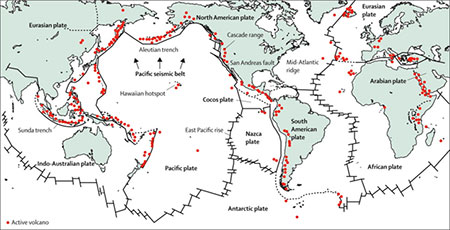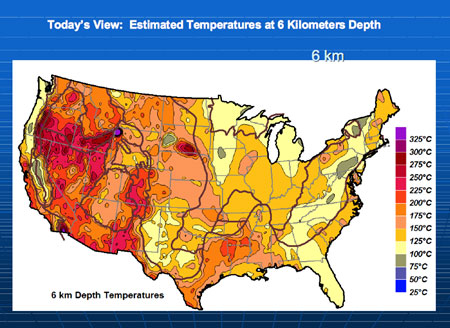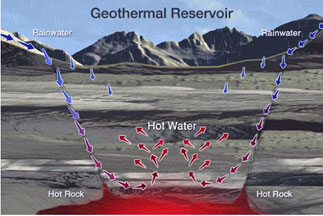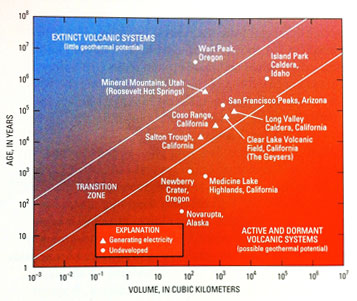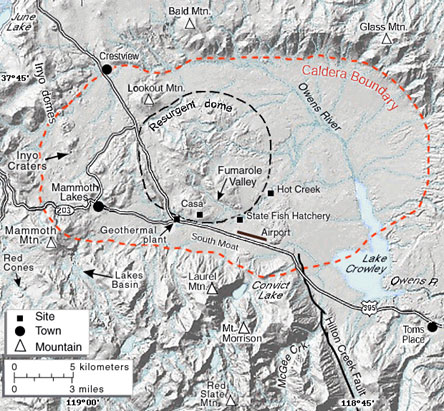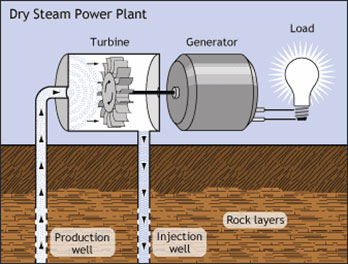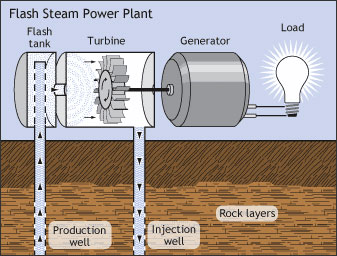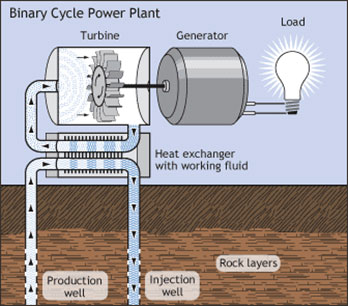Geology and Natural Heritage of the Long Valley Caldera
Geothermal Power in the Long Valley Caldera and Beyond. Policies, Procedures, and Problems
Morgan Mohr
Abstract
This paper provides geological background to geothermal potential and conditions in which geothermal plants can arise, and then reviews existing policy and potential policies that could expand geothermal power in California, the West, and in the rest of the United States. Geothermal energy stems from the heat of the center of the Earth, which can escape more easily between plate boundaries. It takes a young and large body of magma at a shallow depth beneath the surface, as well as permeable and porous rock, in order to support a geothermal power plant. Harvesting heat can be done by Dry Steam, Flash Steam, or Binary Cycle power plants, which all rely on a type of steam turning a turbine. A variety of environmental factors can determine viability of a plant, including impact on land and on the nearby wildlife and vegetation. Though aesthetic impact seems subjective, it serves as an active factor in development analysis. Federal policy consists of various tax incentives, but more importantly the ability of a plant to lease land from a variety of owners, including the Bureau of Land Management or the United States Forest Service. Development in the Long Valley Caldera is discussed extensively in this paper, with a focus on recent geothermal plant expansion in the Casa Diablo IV project.
Introduction
Geothermal energy sits at the intersection of geology and public policy, a result of the rising heat near tectonic boundaries and the source of one of the fastest growing green energy systems. Globally, geothermal energy is the source of 10,000 megawatts (enough for 60 million people) produced in 24 countries. As of 2007, geothermal energy is the fourth largest source of renewable energy in the United States, producing 3,000 megawatts. Geothermal energy in the United States, which is mostly concentrated in California, makes up 30% of the world’s total. Geothermal power plants are growing in the Western United States: 103 development projects are progressing in Alaska, Arizona, California, Colorado, Florida, Hawaii, Idaho, Nevada, New Mexico, Oregon, Utah, Washington, and Wyoming (Blogett, 2007).
Environmental Conditions
Distribution Globally and in the United States
Geothermal energy results from the escape of heat from beneath the Earth’s surface. When magma bodies are closest to the surface, they are hotter and more easily exploitable. Thus, areas of high volcanic activity, found at plate boundaries, are where geothermal energy is most accessible. Figure 1 below shows plate boundaries and sites of active volcanoes, which highly correlate both to sites of geothermal potential and sites of active geothermal energy production.
Figure 1. Tectonic Plates and Active Volcanoes of the World
The hottest subsurface temperatures in the United States are concentrated in the West. This is because California sits at the boundary of the Juan de Fuca plate and the North American plate, allowing magma and its heat to rise close to the surface. Figure 2 below shows subsurface temperatures across the United States, further illustrating the geothermal potential of the West.
Figure 2. Estimated Subsurface Temperatures in the United States
How is a reservoir formed?
A geothermal reservoir depends on a system in which a magma body superheats trapped underground water. Many times the water is meteoric, or comes from snowmelt. After it is heated by the hot rocks below, the water rushes through cracks and faults in the rock, sometimes reaching the surface in the form of hot springs, geysers, or fumaroles (Blogett, 2009, p. 7).
Multiple environmental factors converge in creating conditions for a geothermal power plant. Since the heated water used in geothermal power production is the result of warming from a magma body, the U.S. Geological Survey has (1) established that the volume and age of the magma body determines the heat production capacity and (2) developed a method to examine the size and age of the body from eruption evidence (USGS, 2003). Volume is calculated by the 1:10 rule: "for each volume of magma erupted, about ten times that volume remains inside the Earth’s crust" (USGS, 2003, p. 6). In regards to age, younger bodies produce more heat. Systems fall into three zones in response to categorization by these two factors: Extinct Volcanic Systems, in which there is little to no geothermal potential; Transition Zone, where some already active plants can be found; and Active and Dormant Volcanic Systems, in which geothermal potential exists, but has not yet been harnessed. Examples of these three systems appear in Figure 4 below.
Figure 4. Sites Plotted by Age and Volume of Magma Bodies
Though none are as significant as the age and volume of the magma body, other factors are critical in determining an area»s geothermal energy potential. Not only the size and temperature of the magma body, but its depth determines whether an area is exploitable. Currently, technology permits economically viable drilling around four kilometers in depth (temperatures around 250 degrees Celsius are required for a geothermal power plant). In contrast, most magma bodies around the world are located between 5 and 10 kilometers below the surface (USGS, 2003, p. 10). Therefore, the depth of the magma body is a critical limiting factor in determining geothermal potential of an area. In addition, because of the hydrologic method of extraction, geothermal potential is highly dependent on an area’s rock porosity and permeability. The greater the porosity and permeability (the number of holes in a rock and how well they are connected) the more water is capable of passing through the rock, and therefore the greater the geothermal potential.
Geothermal Potential in the Long Valley Caldera
The Resurgent Dome lies at the center of the Long Valley Caldera, a 20 mile long, 11 mile wide oval-shaped valley next to the Sierra Nevadas in California that resulted from the Bishop Tuff eruption 760,000 years ago. Figure 5 below the Resurgent Dome in the center of the Caldera, flanked by the geothermal power plant.
Figure 5. A Map of the Long Valley Caldera
There are two aquifers, or reserves, found in the Long Valley Caldera. The first, dated 500-700 years, lies 20-120 m below the surface. It is important to note that the aquifer itself is dated 500-700 years ago, not the magma body serving as the source of heat. Relatively young magma bodies, currently estimated to be only a few hundred years old, are assumed to lie beneath the Inyo Crater Chain. In addition, a magma body is thought to exist under the Resurgent Dome, next to the Mammoth-Pacific Geothermal Power Plant. Temperatures of the first aquifer hover above 175°C west of Casa Diablo Hot Springs and decrease eastward. The second aquifer lies 700 m below the surface and is 3,000 years old. Previous research in the center of the Caldera has demonstrated that "There is no evidence at the present time of a large-scale, high-temperature geothermal system associated with the magma chamber identified by seismic studies beneath the resurgent dome" (Blackwell, 1985). Furthermore, despite recent uplift in the dome, no related geothermal activity has resulted (Sass, 2002). Thus, though Mammoth-Pacific is located next to the Resurgent Dome, and a supposed magma chamber beneath is responsible for uplift, there is no connection between that hypothetical magma body and the geothermal potential of the Long Valley Caldera. In fact, Blackwell argues that in both aquifers, the geothermal potential is related to events that raised the temperature from a former 120 degrees, at which the system was circulating beforehand. Before the input event, geothermal potential in the Long Valley Caldera was waning, likely due to the loss of porosity and permeability in the rock due to mineral deposits. The recent heat surge increased the temperature of the pre-existing magma body, possibly increasing the porosity and permeability of the rock (Blackwell, 1985). Thus, the establishment of the Mammoth-Pacific plant in 1984 depended on that recent hydrothermal input. The area behind the Resurgent Dome was within economically viable drilling depths as well.
Geothermal Use
Geothermal Power Plants
There are three systems of collection of geothermal energy, corresponding to three types of geothermal power plants. In a Dry Steam plant, steam inputs straight from the ground and is then injected into the turbine.
Figure 6. Dry Steam Power Plant Diagram
In a Flash Steam power plant, extremely hot water is depressurized and allowed to transform ("flash") into steam, and is then injected into the turbine. This process is used at sites in which the superheated water, extracted from the ground, is subjected to high pressures such that it remains in a liquid state. The liquid nature of the water necessitates the flash technique.
Figure 7. Flash Steam Power Plant Diagram
The third type of power plant is a Binary Cycle, in which hot water is used to heat another liquid (such as isobutane) into steam, which ultimately turns the turbine. This system is employed when hot water is extracted from the ground—not steam. Therefore, in the Long Valley Caldera, where temperatures are often too low to produce pure steam, a binary cycle plant is required (UCS).
Figure 8. Binary Cycle Power Plant Diagram
Renewability
Geothermal energy is legally considered renewable under the National Energy Policy Act (Blodgett, 2007). This is because geothermal plants are capable of extracting the warmed water and reinserting it at a lower temperature, preserving the water source and harvesting only the heat from the core of the Earth; geothermal power seems especially renewable in comparison to fossil fuels, which are resources that can only be renewed over a series of millions of years. However, inserting a geothermal power plant inevitably alters the hydrothermal system. Though geothermal plants claim that reinjecting fluid lower in the Earth prevents the depletion of the reservoir, little research endorses this claim. In some tapped reservoirs, pressure and production declines have been noted (U.S. Department of Energy). Despite these observations, a representative of the Mammoth-Pacific plant (Ormat) stated that the company has little concern regarding the depletion of the reservoir precisely because of their reinjection process, which replenishes the water far deeper in the ground than extraction. This is precisely the conventional wisdom that is well perpetuated but unproven.
Alternate Uses
In the Long Valley Caldera, uses for the used warm water before it is reinjected have been extensively discussed. According to a representative from Mammoth-Pacific, one potential use is to send the warmed water beneath sidewalks in Mammoth, dissolving the need to shovel.
Factors that Influence Policy and Placement of Plants
Environmental Impact
Though geothermal power is widely considered a highly desirable renewable energy source, like all (even renewable) sources of energy, it can give rise to a number of environmental impacts. Noise pollution and water quality are not a problem, since noise is limited to the quiet rumble of fans and water used in the process never comes in contact with surface water. However, the land use of geothermal power plants can cause subsidence into the ground, but more importantly, induced seismicity. The resulting low-magnitude earthquakes are called microearthquakes (Kagel 2007). Finally, like all permanent anthropogenic structures, geothermal power plants can permanently alter and harm wildlife, vegetation, and the local ecosystem. According to a representative of Mammoth-Pacific, geothermal plant activity can alter the location of geysers and fumaroles. When water rushes through the pipes within a geothermal plant, natural mineral deposits accumulate on the pipes. Some of these toxic precipitates, such as arsenic and mercury, require special servicing to remove (Hodder). In addition, binary cycle plants, which employ hydrocarbons, experience additional risks and safety measures, including threats of explosion and fire–even terrorism. A representative from Mammoth-Pacific recently reported a visit from the FBI, as the geothermal plant is considered a potential target.
Social
In general, the only social non-environmental concern in energy analysis is aesthetics. Though this metric is both qualitative and subjective, a 1980 University of California study purely analyzes the recreational industry and aesthetic effects of development in Imperial Valley (Twiss, 1980). This metric plays a large role in determining placement and policy of geothermal power plants.
Long Valley Caldera
Due to recent approval in 2013, Ormat will be expanding geothermal plants in the Casa Diablo IV project, which is expected to double their current generating capacity. Though ultimately the Bureau of Land Management and the United States Forest Service both stamped their approval, several issues discussed in this section were matters of debate in the Caldera. For example, concerns persisted over release of hydrogen sulfide gas and impact on "cultural resources" (Clarke). Vague environmental concerns were put forth as well, including effects on the general hydrothermal system (consisting of the aquifers, local creeks and hot springs) and potential impacts on ecological mainstays, such as on sagebrush and Jeffrey pine. Though impact on general hydrothermal systems are multitudinous as discussed earlier, precisely what ramifications the expansion would have on the vegetation is unclear.
Geothermal Policy
Federal
Currently, a web of legislation frames the United States geothermal power policy. Some regulations are minor, such as qualification for the Department of Energy Tribal Energy Program grant or the U.S. Department of Agriculture Rural Energy for America Program grants. Geothermal plants also qualify for Invest Tax Credits. As of 1978, geothermal plants are required under the Public Utility Regulatory Policies Act to be qualified to sell energy to utilities at avoided cost. In addition, extensive federal funds are available for research and development, such as the DOE’s Geothermal Technologies Program funds research, and the 2008 USGS Grand National resource assessment (National Renewable Energy Laboratory).
State: California
State policy can include a variety of incentives and costs for geothermal development, such as tariffs, grants and loans, tax incentives, and renewable energy standards. A complete list of state policies can be found at the National Renewable Energy Laboratory website at this website. Though California has a Renewables Portfolio Standard, it does not provide the various incentives outlined above: in fact, the state has a feed-in tariff. State policy in California mitigates the vast natural geothermal potential in terms of a development assessment.
Potential Incentives
There are a variety of additional policies the United States or specific states can implement in order to expand geothermal power. First, utility mandates and standards, such as those involving renewables, encourage Americans to diversify in their energy use and looks to decrease national demand for foreign oil. Direct cash incentives constitute an additional option, though this policy allows for developers to use the money in secret, potentially allowing for fraud. Tax incentives, including property tax and sales tax incentives, as well as tax credits, can stimulate development in a regulated fashion. The government, through direct loans or loan guarantees, can also aid in financing. Finally, a legislative method of incentivizing could focus on outreach, training, or technology by developing programs to train workers or provide technical research and assistance (NREL).
Long Valley Caldera Expansion
When the Casa Diablo IV project was approved by the Bureau of Land Management and the U.S. Forestry, the agreement illustrated an additional important piece of geothermal policy: federal land use for geothermal plants. Not only can federal land be leased for plants, but also special legislation exists to combine leases for an area that covers a reservoir, simplifying the process for geothermal developers (NREL). The Casa Diablo expansion occurred despite California’s lack of incentives, but only because federal lands are continually leased to Ormat. The Casa Diablo expansion in the Long Valley proves the economic viability of geothermal power in California, the land of highest geothermal potential in the United States.
Conclusion
In the Long Valley Caldera, expansion by Mammoth–Pacific will soon be underway–the impact on the reservoir and depletion will continue to be evaluated by Ormat. Though California continues to develop geothermal projects despite few state incentives, in other Western states in which geothermal potential is not as lucrative, additional state or federal stimulus could be needed to encourage or stabilize industry growth. As discussed above, hundreds of geothermal projects are developing in the West, but the permanency and the scale of the projects could be determined by policy. Though the rest of the United States lacks the natural potential areas close to the fault have, developing technologies such as the Enhanced Geothermal System could soon create new opportunity for geothermal development in places like Florida. Ultimately, opportunity for growth should be analyzed optimistically, but with care. Though geothermal energy will continue to slow our contribution to global climate change, potential for reservoir depletion and local ecosystem harm are tangible effects that could be easily realized.
References
Barbier, E. (1997). Nature and technology of geothermal energy: a review. Renewable and Sustainable Energy Reviews, 1(1), 1-69.
Blackwell, David D. (1985). A Transient Model of the Geothermal System of the Long Valley Caldera, California. Journal of Geophysical Research, Volume 90 (No. B13), 11,229-11,241.
Blodgett, Leslie (2009). Geothermal 101: Basics of Geothermal Energy Production and Use. Geothermal Energy Association. Retrieved from website
Bloomquist, R. Gordon. (2004). United States Geothermal Policy: Providing Incentives For and Reducing the Risk of Development. Powerpoint found online.
Clake, Chris (2013). Feds OK Expanded Geothermal Plant Near Mammoth Lakes. KCET. Retrieved from website.
Farrar, Christopher D. et al. (2003). Inferences on the hydrothermal system beneath the resurgent dome in Long Valley Caldera, east-central California, USA, from recent pumping tests and geochemical sampling. Journal of Volcanology and Geothermal Research, 127, 305-328.
Fridleifsson, Ingvar B. "Status of geothermal energy amongst the world’s energy sources." Geothermics 32.4 (2003): 379-388.
Hill, Mary. (2003). Geology of the Sierra Nevada: Revised Edition. Berkley and Los Angeles, California: University of California Press.
Hodder, A.P.W. (n.d.). Retrieved from website
Hurwitz, Shaul et al. (2010). The thermal regime in the resurgent dome of Long Valley Caldera, California: Inferences from precision temperature logs in deep wells. Journal of Volcanology and Geothermal Research, 198, 233-240.
Kagel, Alyssa et al. (2007). A Guide to Geothermal Energy and the Environment. Retrieved from website
Lund, J. W., Freeston, D. H., and Boyd, T. L. (2011). Direct utilization of geothermal energy 2010 worldwide review. Geothermics, 40(3), 159-180
Mammoth Pacific Geothermal Power Plants. (n.d.). Project Overview. Mammoth Lakes, CA.
National Renewable Energy Laboratory. (n.d.). Policymaker’s Guidebook for Geothermal Electricity Generation. Retrieved from website.
Office of Energy Efficiency and Renewable Energy. (n.d.). Government Energy Management. Retrieved from website.
Pribnow, Daniel F.C. et al. (2003). Fluid flow in the resurgent dome of Long Valley Caldera: implications from thermal data and deep electrical sounding. Journal of Volcanology and Geothermal Research, 127, 329-345.
Kuo, Gioietta. "Geothermal energy." World Future Review 4.1 (2012): 5-7.
Sass, John (2002). Geothermal California. Retrieved from website.
Twiss, R. (1980). Potential impacts of geothermal development on outdoor recreational use of the Salton Sea. Retrieved from website
Union of Concerned Scientists (n.d.). Clean Energy. Retrieved from website
U.S. Geothermal Development. United States Geological Survey. (2003). Geothermal Energy–Clean Power From the Earth’s Heat (Circular 1249). Reston, Virginia.
List of Figures
Figure 1: Google Images. Retrieved from: website
Figures 2 and 3: Blodgett, Leslie (2009). Geothermal 101: Basics of Geothermal Energy Production and Use. Geothermal Energy Association. Retrieved from website
Figure 4: U.S. Geothermal Development. United States Geological Survey. (2003). Geothermal Energy–Clean Power From the Earth’s Heat (Circular 1249). Reston, Virginia.
Figure 5: Google Images. Retrieved from: website
Figures 6-8: Union of Concerned Scientists (n.d.). Clean Energy. Retrieved from website
[Return to Research Projects] [Return to Sierra Home]
